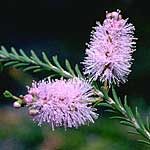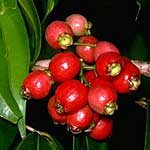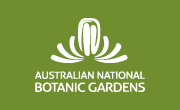Systematics and Evolution (HA)
Myrtaceae
Project Leader: L. Craven
 Melaleuca species occur throughout Australia, with a few species extending into Malesia and a few endemic species in New Caledonia. There are c. 260 species in the genus making it one of the larger such groups of Australian plants; the plants themselves range from being dwarf heathland shrubs to tall woodland trees. They are important elements in the monsoon woodlands, southern and eastern heathlands, and mallee shrublands in the southern arid zone. Species have potential for forestry, as sources of essential oils and other products, degraded-land reclamation, farm tree/windbreak plantings, and ornamental horticulture, among other applications. Taxonomic and floristic studies of Melaleuca and its relatives such as Conothamnus and Regelia are being co-ordinated by Lyn Craven. Species groups in Melaleuca that have high conservation and/or potential agronomic value are being investigated to elucidate their taxonomy; presently the M. uncinata (Broom bush) species complex is the subject of field- and laboratory-based studies in collaboration with Margaret Byrne, CALM, Perth. A survey of the essential oils of Melaleuca is under way with Joe Brophy, University of New South Wales, Sydney. A handbook and CD-ROM (the latter to include an interactive identification system) giving basic information on the botany, distribution, and chemistry of the genus is planned. Melaleuca species occur throughout Australia, with a few species extending into Malesia and a few endemic species in New Caledonia. There are c. 260 species in the genus making it one of the larger such groups of Australian plants; the plants themselves range from being dwarf heathland shrubs to tall woodland trees. They are important elements in the monsoon woodlands, southern and eastern heathlands, and mallee shrublands in the southern arid zone. Species have potential for forestry, as sources of essential oils and other products, degraded-land reclamation, farm tree/windbreak plantings, and ornamental horticulture, among other applications. Taxonomic and floristic studies of Melaleuca and its relatives such as Conothamnus and Regelia are being co-ordinated by Lyn Craven. Species groups in Melaleuca that have high conservation and/or potential agronomic value are being investigated to elucidate their taxonomy; presently the M. uncinata (Broom bush) species complex is the subject of field- and laboratory-based studies in collaboration with Margaret Byrne, CALM, Perth. A survey of the essential oils of Melaleuca is under way with Joe Brophy, University of New South Wales, Sydney. A handbook and CD-ROM (the latter to include an interactive identification system) giving basic information on the botany, distribution, and chemistry of the genus is planned.
 Syzygium has c. 60 species in Australia but is the largest genus of Myrtaceae in the Old World tropics with between 600 and 1000 species. The full range of the genus is from Africa east to the Hawaiian Islands and from India-southern China south to southeastern Australia and New Zealand. Many species are utilised as timber trees; other uses include cloves and cottage fruit trees. Syzygium especially is an important element in the rainforest ecosystem, being a food source for blossom-feeding and fruit-eating animals. There are significant problems to be resolved at generic level as doubts exist as to the validity of at least some of the presently recognised relatives (such as Acmena, Acmenosperma, Cleistocalyx, Piliocalyx, Waterhousea, etc). The taxonomy and morphology of the Australian and Malesian species is being studied by Lyn Craven (with Tom Hartley for those in Papuasia). The phylogeny is being studied with Paul Gadek, James Cook University, Cairns using both morphological and molecular data sets. Due to the inherent difficulties in writing identification keys for specimens lacking flowers and/or fruit, development of interactive identification systems is being given high priority. Syzygium has c. 60 species in Australia but is the largest genus of Myrtaceae in the Old World tropics with between 600 and 1000 species. The full range of the genus is from Africa east to the Hawaiian Islands and from India-southern China south to southeastern Australia and New Zealand. Many species are utilised as timber trees; other uses include cloves and cottage fruit trees. Syzygium especially is an important element in the rainforest ecosystem, being a food source for blossom-feeding and fruit-eating animals. There are significant problems to be resolved at generic level as doubts exist as to the validity of at least some of the presently recognised relatives (such as Acmena, Acmenosperma, Cleistocalyx, Piliocalyx, Waterhousea, etc). The taxonomy and morphology of the Australian and Malesian species is being studied by Lyn Craven (with Tom Hartley for those in Papuasia). The phylogeny is being studied with Paul Gadek, James Cook University, Cairns using both morphological and molecular data sets. Due to the inherent difficulties in writing identification keys for specimens lacking flowers and/or fruit, development of interactive identification systems is being given high priority.
|
![An Australian Government Initiative [logo]](/images/austgovt_canbr_90px.gif)

![An Australian Government Initiative [logo]](/images/austgovt_canbr_90px.gif)



